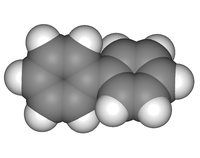- Biphenyl
-
Biphenyl 
 Biphenyl
BiphenylIdentifiers CAS number 92-52-4 
ChemSpider 6828 
UNII 2L9GJK6MGN 
KEGG C06588 
ChEBI CHEBI:17097 
ChEMBL CHEMBL14092 
Jmol-3D images Image 1 - c1ccc(cc1)c2ccccc2
Properties Molecular formula C12H10 Molar mass 154.21 g mol−1 Appearance colorless crystals Density 1.04 g/cm3 Melting point 68.93 °C, 342 K, 156 °F
Boiling point 256 °C, 529 K, 493 °F
Solubility in water Insoluble Hazards EU Index 601-042-00-8 EU classification Irritant (Xi)
Dangerous for
the environment (N)R-phrases R36/37/38, R50/53 S-phrases (S2), S23, S60, S61 NFPA 704 Flash point 113 °C Autoignition
temperature540 °C  (verify) (what is:
(verify) (what is:  /
/ ?)
?)
Except where noted otherwise, data are given for materials in their standard state (at 25 °C, 100 kPa)Infobox references Biphenyl (or diphenyl or phenylbenzene or 1,1'-biphenyl or lemonene) is an organic compound that forms colorless crystals. It has a distinctively pleasant smell. Biphenyl is an aromatic hydrocarbon with a molecular formula (C6H5)2. It is notable as a starting material for the production of polychlorinated biphenyls (PCBs), which were once widely used as dielectric fluids and heat transfer agents. Biphenyl is also an intermediate for the production of a host of other organic compounds such as emulsifiers, optical brighteners, crop protection products, and plastics.
Contents
Properties
Biphenyl occurs naturally in coal tar, crude oil, and natural gas and can be isolated from these sources via distillation. It can also be synthesized by using a grignard reagent such as phenylmagnesium bromide and reacting it with bromobenzene. Biphenyl is insoluble in water, but soluble in typical organic solvents. The biphenyl molecule consists of two connected phenyl rings. Lacking functional groups, it is fairly non-reactive. It will, however, participate in many of the reactions that are typical for benzene, for example, substitution reactions upon treatment with halogens in the presence of a Lewis acid.
Stereochemistry
Rotation about the single bond in biphenyl, and especially its ortho-substituted derivatives, is sterically hindered. For this reason, some substituted biphenyls show atropisomerism; that is, the individual C2-symmetric-isomers are optically stable. Some derivatives, as well as related molecules such as BINAP, find application as ligands in asymmetric synthesis. In the case of unsubstituted biphenyl, the equilibrium torsional angle is 44.4° and the torsional barriers are quite small, 6.0 kJ/mol at 0° and 6.5 kJ/mol at 90°.[1] Adding ortho substituents greatly increases the barrier: in the case of the 2,2'-dimethyl derivative, the barrier is 17.4 kcal/mol (72.8 kJ/mol).[2]
Biological aspects
Biphenyl prevents the growth of molds and fungus, and is therefore used as a preservative (E230, in combination with E231, E232 and E233), particularly in the preservation of citrus fruits during transportation.
It is mildly toxic, but can be degraded biologically by conversion into nontoxic compounds. Some bacteria are able to hydroxylate biphenyl and its polychlorinated biphenyls (PCBs). [3]
It is part of the active group in the antibiotic oritavancin.
Biphenyl compounds
Substituted biphenyls can be prepared synthetically by various coupling reactions including the Suzuki reaction and the Ullmann reaction and have many uses. Polychlorinated biphenyls were once used as cooling and insulating fluids and polybrominated biphenyls are flame retardants. The biphenyl motif also appears in drugs such as valsartan and telmisartan. The abbreviation E7 stands for a liquid crystal mixture consisting of several cyanobiphenyls with long aliphatic tails used commercially in liquid crystal displays. A variety of benzidine derivatives are used in dyes and polymers. Research into biphenyl liquid crystal candidates mainly focuses on molecules with highly polar heads (for example cyano or halide groups) and aliphatic tails.
See also
- Triphenyl
- Terpyridine
- Terthiophene
- Naphthalene where the rings are fused.
- Tricyclobutabenzene contains two more hydrogen atoms than biphenyl
References
- ^ Mikael P. Johansson and Jeppe Olsen (2008). "Torsional Barriers and Equilibrium Angle of Biphenyl: Reconciling Theory with Experiment". J. Chem. Theory Comput. 4 (9): 1460. doi:10.1021/ct800182e.
- ^ B. Testa (1982). "The geometry of molecules: basic principles and nomenclatures". In Christoph Tamm. Stereochemistry. Elsevier. pp. 18.
- ^ Biphenyl degradation - Streptomyces coelicolor, at GenomeNet Database
- Biphenyl (1,1- Biphenyl). Wiley/VCH, Weinheim (1991), ISBN 3-527-28277-7
External links
Categories:- Biphenyls
- Preservatives
Wikimedia Foundation. 2010.

